Novel Writing: Le Morte d’Arthur
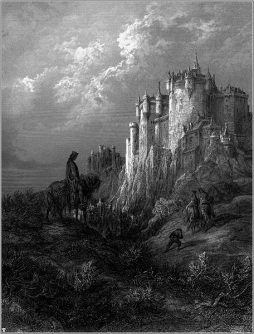 National Novel Writing Month is well underway for me. I’ve gotten a start on my novel, at the same time as I’m still getting the structure figured out. I’ll have some thoughts on my process, and what I’m learning, a bit later in this post; first, I want to write a bit about the subject I’m wrestling with, the Matter of Britain.
National Novel Writing Month is well underway for me. I’ve gotten a start on my novel, at the same time as I’m still getting the structure figured out. I’ll have some thoughts on my process, and what I’m learning, a bit later in this post; first, I want to write a bit about the subject I’m wrestling with, the Matter of Britain.
I’m writing an Arthurian fantasy. Like, I’d imagine, most people, I’ve been vaguely familiar with the stories of Arthur and his knights since I was very young. At different times in my life I’ve been more or less intensely interested in different aspects of the Arthurian tales and the way they developed over time; writing a story using that material, though, forces a new perspective on me.
I’ve had to think a lot about what precisely interests me about these stories. And which stories, in particular, have grabbed me? Why do they matter? Why do I want to write about them?
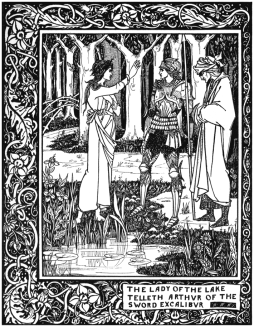 I don’t know if it’s possible to answer these questions briefly. In some ways, writing the novel is the only way I can answer them. But I have observed a few things, partly based on what I find myself writing, and partly on what I’ve read as research for the tale I have in mind to tell.
I don’t know if it’s possible to answer these questions briefly. In some ways, writing the novel is the only way I can answer them. But I have observed a few things, partly based on what I find myself writing, and partly on what I’ve read as research for the tale I have in mind to tell.
To begin with, I’d decided that I’d work primarily with Thomas Malory’s Le Morte d’Arthur as my main source. This plan has not lasted long, as I find myself turning more and more to Welsh legendary material. Which I’ve found very resonant; it’s immensely tempting to try to get at the wonder of the medieval triads and poems. The problem is that these early works are so fragmented, they’re difficult to entirely grasp. Which means I need an overall structure for them. Which brings me back to Le Morte d’Arthur.
The history of Arthurian literature is long and complex; briefly, the figure of Arthur seems to have emerged in Welsh legend, much of which has not survived, and appears occasionally in early chronicle histories of post-Roman England, before being given full treatment in Geoffrey of Monmouth’s History of the Kings of Britain in 1136. That inspired not only other histories, but also long romances—early fantasy fiction, if you like—in Europe.
Thomas Malory’s Morte d’Arthur took those romances, which were not necessarily consistent with each other, and (as I read the book; there’s a complex textual history behind it) tried to work them all into a coherent whole. It became the standard Arthurian text, especially in English. Oddly, it seems to me that Tennyson’s Idylls of the King, a long poem (written between 1859 and 1885) that was very faithful to Malory, has kicked off an era of rewriting or rethinking Arthur, a movement away from its source.
At any rate, Malory wrote in the fifteenth century, a very different time and society than the first Welsh writers and chroniclers. It was natural then to imagine your characters as contemporaries; the idea that a different time implied a different culture didn’t really exist. So Malory had a very fifteenth-century view of his knights, shaped by the ideals of chivalry then current, and had them participate in tournaments and jousts in a way that seemed natural to him.
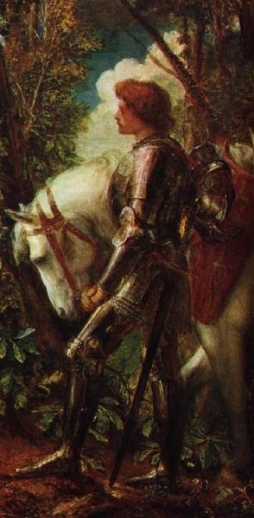 But the Arthurian stories still represent several different kinds of stories, several different genres and sub-genres, all present in Malory, however subliminally. You have legend; prophecy; chronicle history; fairy tale; Christian homily; adventure; love story; arguably even some attempts at realism, proto-novelistic details. The Arthur tales are a kind of framework in which these different forms meet and make something new. Different retellings of the stories, and different parts of those retellings, emphasise different aspects, different genres. Working out what you want to do with the Arthurian material creatively involves working out what aspects you want to use where, which you want to play up and which you find comparatively less interesting.
But the Arthurian stories still represent several different kinds of stories, several different genres and sub-genres, all present in Malory, however subliminally. You have legend; prophecy; chronicle history; fairy tale; Christian homily; adventure; love story; arguably even some attempts at realism, proto-novelistic details. The Arthur tales are a kind of framework in which these different forms meet and make something new. Different retellings of the stories, and different parts of those retellings, emphasise different aspects, different genres. Working out what you want to do with the Arthurian material creatively involves working out what aspects you want to use where, which you want to play up and which you find comparatively less interesting.
Even to say “the Arthurian material” is a broad term. The character of Arthur has attracted other legendary material to it; characters like Merlin or Tristram originally had their own stories, which over time became drawn to and submerged within the Arthurian framework. So you can also look at the Arthurian tales as a kind of ‘shared world’ in which legends meet and are made to cohere each with another.
Which is what makes Malory particularly intriguing to me, as a conscious attempt to bring together a range of stories and traditions. Malory’s prose is laconic, more like a Norse saga than a modern novel; I find you have to pay closer attention to such writing than to novelistic prose, or at least a different kind of attention. Characterisation, for example, is handled differently—you’re rarely told what a character feels or why, and you may not get a wholly detailed background, but if you look closely, you’ll see how a character’s actions are informed by emotion.
For example, one of the major subplots of Malory’s book involves a conflict between Sir Gawain and his brothers with the family of King Pellinore, who killed Gawain’s father King Lot. You have to pay attention to which characters are related to which, and how; Malory doesn’t always spell it out. And I think the conflict is understated in relation to the way a contemporary novelist would describe the vendetta and its consequences and emotional effects.
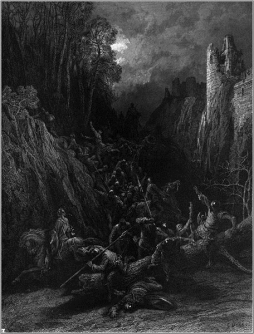 Certainly Malory makes some odd structural choices. The death of Pellinore’s son Sir Lamorak, for example, isn’t given ‘on-camera’; you have characters suddenly start referring to Lamorak as being dead, and after a few chapters some other characters describe what they heard about how he died. It’s effective, but elliptical.
Certainly Malory makes some odd structural choices. The death of Pellinore’s son Sir Lamorak, for example, isn’t given ‘on-camera’; you have characters suddenly start referring to Lamorak as being dead, and after a few chapters some other characters describe what they heard about how he died. It’s effective, but elliptical.
It also frankly happens that Malory has his lapses. He seems to have two different Grail Kings, Pelles and Pellam, confused with each other. A minor character, Sir (or King) Bagdemagus appears to have a different role every time he turns up in the book.
On the other hand, to me there’s clearly a careful structure to the book. Events are foreshadowed; prophecies made early in the book are paid off later on; the chronology, though confusing, seems to work out coherently, producing a sense of a long and varied reign, ending on a battlefield. Moreover, it seems to me that despite the many narrative strands Malory keeps going, he’s mostly able to keep a sense of unity, both in the sense that his book feels like one story with a long arc to it, and in the sense that (what I take to be) his themes of morality and right behaviour feel coherent.
It’s fascinating to me to see the way various organising principles can be traced through the work. The Gawain/Pellinore feud is one example, a subplot that helps define and structure various tensions among the knights of the Round Table. The quest for the Holy Grail is obviously another, something set up early in the book when a knight strikes a Dolorous Stroke with the spear that pierced the side of Christ, thereby wounding a king and creating a Waste Land only healed by the eventual achievement of the Grail. The relationship of Launcelot and Guenevere is another example—something which plays into the Grail Quest, and which also plays into the climax of the whole work, as the Round Table falls into a civil war.
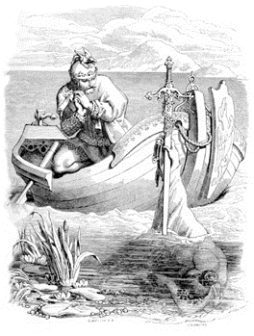 Which is not to say the book necessarily always feels taut. The first time I read Le Morte d’Arthur, I frankly lost interest in the middle of Book X, a long and seemingly shapeless section which mainly seems to have to do with jousts and tourneys and the soap-opera tensions between Sir Tristram, Sir Palomides, and La Beale Isoud (who is loved by both men), as well as the adventures of various minor characters. There’s a jump in the middle of the section of ten years or more, and it’s generally difficult to view as a unity.
Which is not to say the book necessarily always feels taut. The first time I read Le Morte d’Arthur, I frankly lost interest in the middle of Book X, a long and seemingly shapeless section which mainly seems to have to do with jousts and tourneys and the soap-opera tensions between Sir Tristram, Sir Palomides, and La Beale Isoud (who is loved by both men), as well as the adventures of various minor characters. There’s a jump in the middle of the section of ten years or more, and it’s generally difficult to view as a unity.
It also has little of the sense of mystery or wonder that comes with the appearance of magic or miraculous events. Personally, that’s something which always drew me to the Arthurian tales. But on the other hand, I think this part of the book features some of Malory’s strongest character work.
And Malory’s characterisation is often underrated, I think. To me, the various knights are very different personalities. The genial and playfully clever Sir Tristam (who “learned to be a harper passing all others”) is distinct from the conscious idealism and seriousness of Sir Launcelot; the “scoffing and japing” of Sir Dinadan is different from the crueler mockery of Sir Kay. Sir Palomides and Sir Tristram react differently to being in love with the same woman. Sir Tristram and Sir Launcelot react differently to being in love with a Queen married to a King. Personalities, I feel, emerge strongly from the work.
I’d go so far as to say that at times Malory consciously seems to approach realism. Consider Modred arguing to a sharp-tongued woman that a young knight shows promise:
By my head, said Sir Mordred to the damosel, ye are greatly to blame so to rebuke him, for I warn you plainly he is a good knight, and I doubt not but he shall prove a noble knight; but as yet he may not yet sit sure on horseback, for he that shall be a good horseman it must come of usage and exercise. But when he cometh to the strokes of his sword he is then noble and mighty, and that saw Sir Bleoberis and Sir Palomides, for wit ye well they are wily men of arms, and anon they know when they see a young knight by his riding, how they are sure to give him a fall from his horse or a great buffet. But for the most part they will not light on foot with young knights, for they are wight and strongly armed. For in likewise Sir Launcelot du Lake, when he was first made knight, he was often put to the worse upon horseback, but ever upon foot he recovered his renown, and slew and defoiled many knights of the Round Table. And therefore the rebukes that Sir Launcelot did unto many knights causeth them that be men of prowess to beware; for often I have seen the old proved knights rebuked and slain by them that were but young beginners. Thus they rode sure talking by the way together.
To me, there seems to be some actual knowledge of how jousting really works in that discussion. Or you can see flashes of character-based realism in the following dialogue when Sir Dinadan (“the merriest knight that ever ye spake withal, and the maddest talker”) meets Isoud, the beloved of his friend Sir Tristan:
Anon La Beale Isoud came unto him, and either saluted other; then she asked him of whence that he was. Madam, said Dinadan, I am of the court of King Arthur, and knight of the Table Round, and my name is Sir Dinadan. What do ye in this country? said La Beale Isoud. Madam, said he, I seek Sir Tristram the good knight, for it was told me that he was in this country. It may well be, said La Beale Isoud, but I am not ware of him. Madam, said Dinadan, I marvel of Sir Tristram and mo other lovers, what aileth them to be so mad and so sotted upon women. Why, said La Beale Isoud, are ye a knight and be no lover? it is shame to you: wherefore ye may not be called a good knight [but] if ye make a quarrel for a lady. God defend me, said Dinadan, for the joy of love is too short, and the sorrow thereof, and what cometh thereof, dureth over long. Ah, said La Beale Isoud, say ye not so, for here fast by was the good knight Sir Bleoberis, that fought with three knights at once for a damosel’s sake, and he won her afore the King of Northumberland. It was so, said Sir Dinadan, for I know him well for a good knight and a noble, and come of noble blood; for all be noble knights of whom he is come of, that is Sir Launcelot du Lake.
Now I pray you, said La Beale Isoud, tell me will you fight for my love with three knights that do me great wrong? and insomuch as ye be a knight of King Arthur’s I require you to do battle for me. Then Sir Dinadan said: I shall say you ye be as fair a lady as ever I saw any, and much fairer than is my lady Queen Guenever, but wit ye well at one word, I will not fight for you with three knights, Jesu defend me. Then Isoud laughed, and had good game at him.
To me there’s something very vivid in that, something in the mixture of formality and frankness that feels like two people talking; specifically, something that feels like two people, both of them close to a third person who is not present, as they meet for the first time, and go from being tense around one another to enjoying each other’s company. Admittedly, these are two people in a distant culture, but people nevertheless. It helps, perhaps, that Dinadan’s one of the best things in Malory; unpredictable, often funny, a fine warrior but not one of the best knights in the world (as Tristram and Launcelot are) and therefore fallible in a way they aren’t, in combat and out of it.
I think that one of the typically subtle aspects of how Malory depicts his characters is in the passage of time. It’s possible to put together a chronology of the book (here’s one example), and see how the characters stand to each other in terms of their relative ages. To me, if you look closely, you can see the characters mature and grow old; Arthur the young man is vigorous but occasionally unwise, but as he ages he grows less prone to personal combat, until the breaking of the Round Table forces him again into action.
There is in fact almost a generational aspect to the book, which oddly mimics the actual sequence of stories. That is, originally Gawain was the greatest knight of Arthur’s court; then Launcelot; then, later, Grail knights like Perceval and then Galahad. So in Malory, Gawain is the greatest knight of the first days of the Round Table, then Launcelot arrives on the scene, and then a young Perceval is introduced, and then Galahad after him.
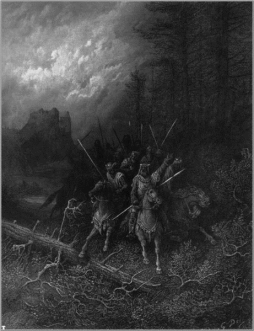 Conversely, Malory’s reworking of his text has moved us away from the original chronicles of Arthur as a historical entity. There’s no discussion of invading Saxons. But there are references to knights going on crusade, and indeed to pagan “Saracens”—which is notable since Islam wasn’t founded until after the ‘historical’ Arthur’s reign.
Conversely, Malory’s reworking of his text has moved us away from the original chronicles of Arthur as a historical entity. There’s no discussion of invading Saxons. But there are references to knights going on crusade, and indeed to pagan “Saracens”—which is notable since Islam wasn’t founded until after the ‘historical’ Arthur’s reign.
Generally Malory presents an oddly fantastic feel; there’s a fictional geography to his England, filled with names like Logres, Surluse, and Lyonesse. Some of those names, like Northgalis (North Wales), can be equated to actual places; others are more mysterious. But overall, it seems to me that there’s a sense of place to Malory. It seems to me that you can follow much of the action of the book through references to known locations. But, surprisingly, not to obvious ones; London rarely enters into the book (although Modred besieges Guenevere in the Tower towards the end). Much of it seems to take place in the area of Wales and Cornwall—the original stories and settings of the Arthur tales still demonstrating their influence.
 As I said, Le Morte d’Arthur’s not always entirely consistent. But the contradictions in Malory, and in the material Malory was working with, can I think act as a spur to creativity. How do you read this text? How do you want to rewrite it? The book itself seems to provide a range of options, a number of hints. You can take from it what you want. Is there magic? How common is it? Is Merlin alive? Or dead? Is Morgan le Fay an implacable enemy of the Round Table, or a more ambiguous figure?
As I said, Le Morte d’Arthur’s not always entirely consistent. But the contradictions in Malory, and in the material Malory was working with, can I think act as a spur to creativity. How do you read this text? How do you want to rewrite it? The book itself seems to provide a range of options, a number of hints. You can take from it what you want. Is there magic? How common is it? Is Merlin alive? Or dead? Is Morgan le Fay an implacable enemy of the Round Table, or a more ambiguous figure?
People have been proposing various approaches to Arthur for a long time. Particularly since Frazier’s groundbreaking work of comparative mythology The Golden Bough, there’s been an urge to analyse the Arthurian tales as legend and folktale, as incarnating the outline of a fertility myth. On the other hand, you can look at them as an example of how a tradition changes over time; an example of the transmission of narrative. Or as the way aspects of culture—fashion, beliefs, behaviours—can be incorporated into wonder stories. You can look at them a lot of different ways.
And most of those ways are somewhere in Malory.
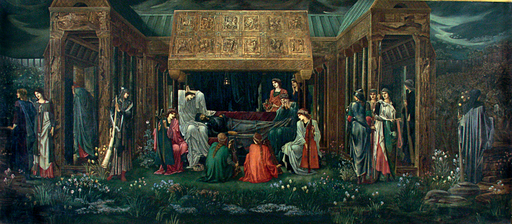
In terms of the actual writing of my novel: I spent a couple of days working out where I was going with it, and then on Thursday accepted a writing challenge. These challenges are posted on the Nanowrimo boards for anybody who wants to pick up on them; sometimes they involve incorporating a particular word or image or character into your story, as a way to spark your imagination. The challenge I signed on for, though, was simply for word count: to have written 10,116 words by the end of Saturday (10/11/6).
At the time I agreed to the challenge, I was at about 800 words, since I’d been focussing on my outline. I knew I needed to get my word count up if I was to hit my goal by the end of the month. I succeeded, reaching above 10,200 words by the time I turned in Saturday night.
The problem, of course, is that I’m still not at the end of my prologue.
That happens. Some parts of a story go long, some go short. I already have ideas about how to trim it, after I complete a whole first draft. I might move some pieces around. I might cut some large chunks. I don’t know; that’s all to be decided in future months, when Nanowrimo’s done.
For the moment, even if I end up cutting everything I’ve written so far in some hypothetical future draft, I’m learning a lot about my main character, and about his background. Also about the world of the story. I might choose to change all of this, of course, but I’m generating ideas, connections, incidents; and that gives me a store of notions to work with. Concrete ideas. It’s a good start.
But it’s a long way from finished.
Matthew David Surridge is the author of “The Word of Azrael,” from Black Gate 14. His blog is Hochelaga Depicta.
Some fascinating thoughts on a very important work here.
I studied the Morte at university last year, and it inspired my Arthurian novel idea. I’ll need to actually read the thing in its entirety before I start serious work on it, though! (Yes, I’m the worst ever.)
Anyway, I’m looking forward to more updates about your Nanowrimo project.
Thanks for the interest, Cephalophore!
One of the things about Le Morte — it’s long. It’s something like 300,000 words, which helps put things in perspective for me as I read it. Even if I hit the 100,000 word-count that I’m going for, it’s still only be a third the length of Malory’s text. On the other hand, the more I read it, the more I find inspiration in it, so … I suppose it works out.
[…] Black Gate Tags: d’Arthur, Morte, Novel, Writing […]
[…] continues. I’m adding to my word count, generating text and ideas. Last week, I talked about Malory’s Le Morte d’Arthur, which I’m using as a source text for my novel, […]
[…] in National Novel Writing Month (you can see my previous thoughts on this year’s NaNoWriMo here, here, here, and here). Still, a few things have become clear to me about the shape of my story; I seem […]
Good luck with the Round Table, and Nanowriimo. I’ve done the whole Nano thing a couple of times, and it’s a wild ride. Actually, the novella John bought for some future issue of BG started out as the first movement of my Nano project. Looking forward to seeing where the month takes you!
My only foray into Arthuriana is also my only foray into slipstreamish postmodernish weird fiction. It’s here as a 20 minute podcast.
I finally read Le Morte d’Arthur while I was tutoring two kids who were native speakers of Mandarin and had no clue about the Matter of Britain, but they’d fallen in love with Garth Nix’s Sabriel books and wanted to do the three Arthurian short stories in his Across the Wall collection. We had to get them basic grounding in the original first, so we slogged through a modernized rendering of Malory together. It was a real stretch, with their ESL issues, and they were often confused, but they found a lot to love in Malory. Then the Nix stories. Then T.H. White. We only stopped with the Arthuriana a year after starting it, when I took a break from tutoring to have a baby. I ended up naming my son after Sir Gareth.